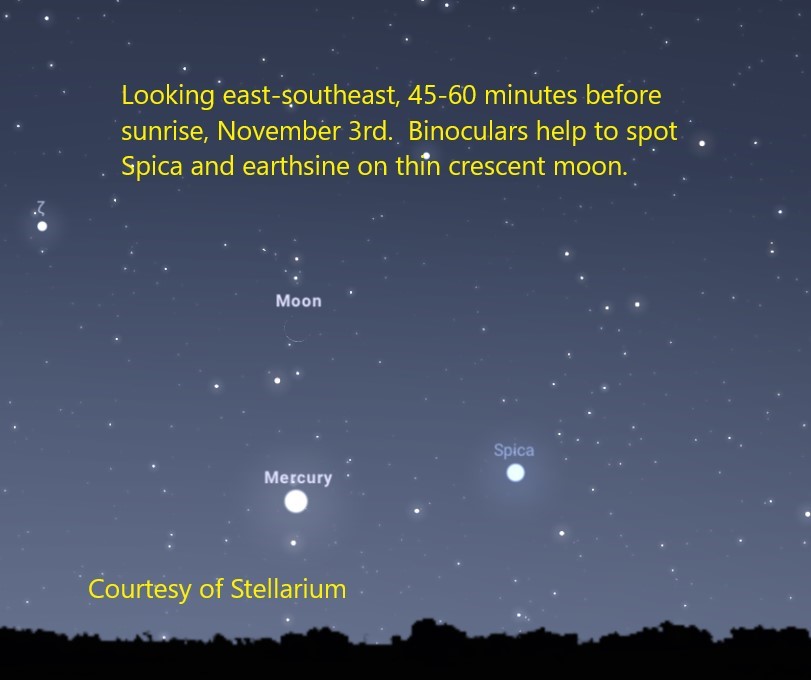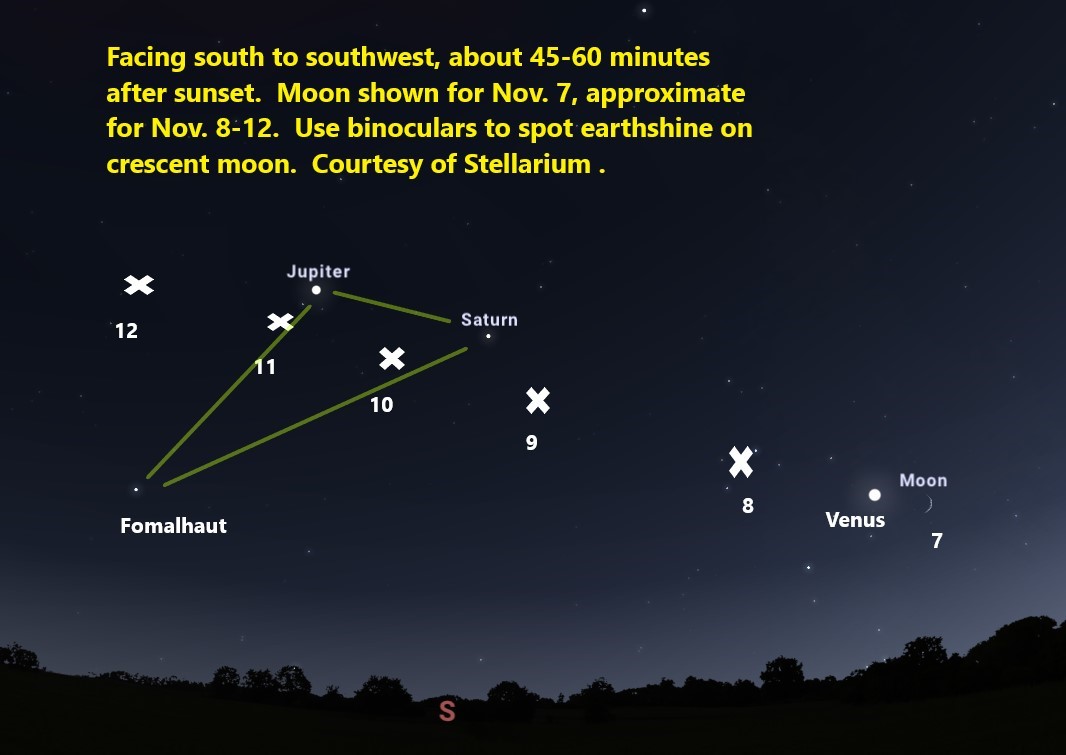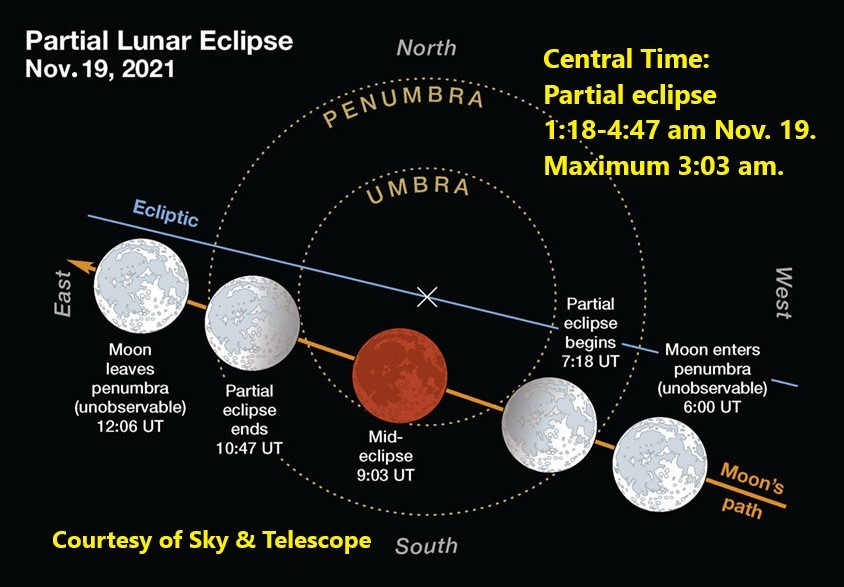Although our Moon is just one fourth Earth’s diameter and reflects just 12% of the Sun’s light back towards Earth, it still dominates the night skies, and is often also visible during daylight. This is because the Moon is so much nearer to us than all other objects. At an average of about 239,000 miles distant from Earth, the Moon is about 100 times nearer to us than is Venus, the nearest planet. It is approximately 400 times closer than the Sun. Compared to the stars, the difference in distance is mind-boggling, as light from the Moon takes just over a second to get to your eyes, as opposed to over 4 years for the nearest star besides the Sun.The Moon Points the Way.
As the moon orbits the Earth, taking 27.3 days, it appears to change its position in the sky every night, roughly about the width of your hand as seen at arm’s length. Thus the moon can point the way to other objects in the sky- except that the glare of a bright moon can make it hard to spot these other objects at all! Fortunately, the five planets nearest to us are bright enough that this is not a problem, and during November, the Moon can help us find four of them.
Early in November, the Moon passes increasingly between Earth and Sun, presenting an ever-thinner crescent and rising in the predawn hours closer and closer to sunrise. As mentioned last month, a beautiful, slender crescent can be glimpsed on the morning of November 3, about 45-60 minutes before sunrise. Look below the moon for yellowish or pinkish Mercury, low in the southeastern sky, if you can find a spot with an open view in that direction. Mercury currently on the far side of the Sun as seen from Earth. It will drop out of view within a few days after the 3rd. Binoculars can help spot Mercury more easily and reveal the star Spica to the right, as well as to glimpse earthshine- the outline of the unlit part of the moon.

Usually elusive Mercury can be found below the thin waning crescent moon on the morning of November 3rd.
The Moon passes almost directly between Earth and Sun, presenting its new phase, on the night of the 4th, and then moves into the evening sky as we see it in its orbit. Beginning on the night of the 7th, a thin crescent can be seen each night, waxing or increasing in thickness each night. The moon will pass first Venus, then Saturn, and finally Jupiter between the 7th and 12th, helping to cinch the identification of these already every easy-to-see planets. Jupiter and Saturn outshine all objects in the night sky except for the Moon, while Saturn appears about as bright as the brighter stars in the sky.

The very thin crescent moon shines close to Venus at dusk on the evening of November 7th, and then continues in its obit, passing in the vicinity of Saturn and Jupiter between the 9th and 12th.
The moon will go through its hump-shaped gibbous phase around mid-November, and then will be Full on Thursday night/Friday morning November 18/19. In fact, the Sun-Earth-Moon alignment will be so perfect that there will be a nearly total Lunar Eclipse that evening. Since it is the Moon that will be in the Earth’s shadow, a lunar eclipse is perfectly safe to look at. Since some light filters around Earth’s atmosphere, the Moon does not usually completely disappear during an eclipse but instead shows an orange or red color. In recent years, this has often come to be called a “blood moon.” Binoculars or a small telescope can help show the details of the umbra, or shadowed part of the Moon.
Since the Arch is open seven days a week, many of us Park Rangers have our days off during the week, so this eclipse times out perfectly on this writer’s days off. However, most people will have to go to work on a Friday morning. Also, the Earth, Moon, and Sun do not obey our hours of sleep. As can be seen from the chart below, the main part of the event will take place from 1:18-4:47 am St. Louis time, with maximum at 3:03 am. At that moment, about 97% of the Moon will be within Earth’s dark umbral shadow. A slight penumbral shading might be seen up to a half hour before or after the umbral portion of the eclipse.

The moon will be almost entirely within Earth’s dark umbral shadow near maximum eclipse.
Try taking some pictures of the eclipse. It will help to place your camera on a tripod or prop it up on something so that your aim is steady. A very short exposure will reveal details on the bright part of the Moon, along with the “bite” taken out by Earth’s shadow, while a longer exposure reveals the reddish umbra. It can be nearly impossible to get both at the same time, but it might be fun to try anyway!
I would not blame anyone who does not feel like staying up super late or waking up super-early on a work day for most people. If you don’t catch this one, there will only be a six month wait until a completely total eclipse on the night of May 15, 2022. Even better, the eclipse begins at the much more favorable time (for most people) of 10:29 pm. This, plus May in the Midwest tends to be clearer more often than November, which is often cloudy and chilly. True believers like me of course will be out to see both eclipses.
The Gateway to the Stars program is complete for 2021. The program is expected to return in May 2022, with a schedule of monthly telescope viewing and astronomy and National Park related educational programming.
